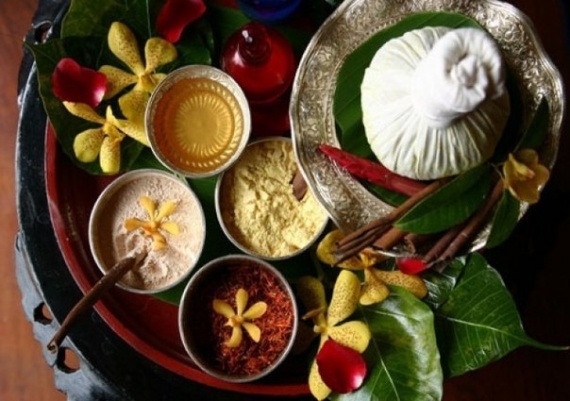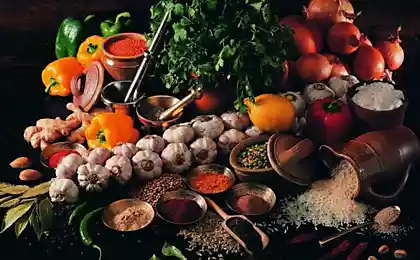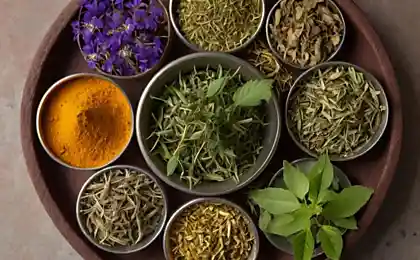2334
Ayurveda. Energy grasses

Ayurveda comes to herbs from the standpoint of the science of energy. Properties of herbs are systematically connected with their taste, their elemental composition, the effects of heating and cooling, as well as have an effect after digestion, as well as their other potentials that are inherent in them.
In contrast to the complexity of chemical analysis, in which case we often get lost in the vast abundance of details, this simple system energy clarifies the fundamental properties of herbs. It gives us a framework within which they are easily identifiable and accessible understanding. Therefore, they can be applied to individual constitution and condition of the body.
This system of energy grasses is a major factor in understanding plant teachings of Ayurveda. Chinese herbalism has a similar system of taste and energy. The fact that in western herbalism such a system does not exist, determines its limits.
In this book, we try to explain the action of many used in the West herbs in accordance with the ideas of Energy in Ayurveda. We hope that we will thus eliminate this gap and facilitate the use of herbs in the typical East high level - an understanding of the principles of energy is an important prerequisite for successful treatment.
Taste (rasa)
Ayurveda says that the taste of grass is not something accidental, but is an indicator of its quality. Different flavors inherent in different effects.
We do not usually associate the taste with medicinal properties. When it comes to taste, then we come to taste only from the standpoint of food gives us pleasure. In the western herbalism believe that taste plants is increasingly means identification, rather than a means of understanding the resulting action. In general, it is recognized that the sharp, pungent herbs have a warming and stimulating effect, or that the bitter herbs help reduce fever, but this position is not the basis for the classification of herbs for their taste.
The Sanskrit word for the taste, "race" has many meanings. All of them help us to understand the value that gives the taste of Ayurveda. Race means "essence" thus refers to the essence of the taste of the plant and is thus probably the main criterion in recognition of its qualities.
Race means "juice", so that the taste of one or another herb reflects the properties of juice, which gives effect to this plant. Race also means "to give high praise", "artistry and enthusiasm", "musical note"; thus makes the taste sensory perception, which is also the essence of the plant. Plants may be perceived because of their beauty and power. Race means "circulation", "feel, feel a sense of recovery", "dance", and all of these values are reflected in the energizing power of taste.
Taste directly affects our nervous system through the prana, the life force in the mouth, which is associated with prana brain. Taste stimulates the nerves, awakens consciousness and feeling, giving us so cheerfulness and sense of recovery. Thus, the taste sets in motion our own race, or vital fluid. By stimulating prana, especially the nerves of the stomach, taste affects the agni and increases the possibility of digestion.
It was a nice taste of food is necessary in order to intensify our agni and thereby ensure adequate digestion. It is for this reason that food is not endowed with such taste, can be dense nutrient-poor, despite its adequate vitamin or mineral composition. In the case where there is no proper stimulation Agni our digestion is insufficient. Therefore, Ayurvedic medicine has always included the science of cooking, which uses appropriate spices. Taken together, they are part of the region, part of the sphere of science about plants Ayurveda (Ayurvedic gerbalnoy science).
When we are sick, we lose the sense of taste and appetite. Taste, appetite and digestive capacity linked. Lack of taste indicates a fever, a disease of low agni and high - ama. In order to improve the condition of agni and eliminate the disease, it is necessary to improve our taste, our sense of taste. That is why spices are so important plants within Ayurveda. Craving for delicious food indicates "hungry" agni, or the presence of disease. The difficulty lies in the fact that we have distorted our sense of taste, by using artificial materials.
Taste - a sensory quality that belongs to the element of water. Plants represent a form of life related to the water element. Consequently, the taste and reflects energy elements which are operating in a particular plant.
Rainwater initially has no taste, but in a latent state it has all the flavor characteristics. These flavors are cumulated on as rainwater falls on the ground, passing through the five elements of the atmosphere and borrows their quality.
Ayurveda distinguishes six main characteristics of taste:
sweet
sour
salty
acute (caustic)
bitter
astringent
These taste characteristics are derived from the five elements. Every taste is composed by two elements.
Sweet taste is composed of earth and water;
sour - of earth and fire;
salty - from water and fire;
sharp (acrid) - from fire and air;
bitter - from air and ether;
viscous - from the ground and air.
Have a sweeter taste, mainly sugars and starches. Sour taste - the taste of foods that have undergone fermentation or are acidic. Salty taste - the taste of salt and alkali. Spicy pungent taste identical or caustic, and often is aromatic. Bitter taste - the taste of bitter herbs such as gentian. Viscous taste astringent, like plants, which contain tannin, such as oak bark.
Although the taste of the six transmitting properties of the five elements, they are all based on a water element that exhibits blocked. We recognize the taste only if our language is moistened.
Energy (Veerya)
Viriya - the energy potency. or the power of herbs in Ayurveda as denoting warming or cooling. Herbs, due to their inherent taste, or have the ability to heat the body, or cool it, that is energized fundamental effect on our system.
Pungent taste, as is well known, the inherent hot pepper, red pepper, ginger and other spices burning, has a warming effect.
Products having a sour taste, such as citrus fruits or fermented products, such as wine or pickled products provide a warming effect. Fermentation leads to combustion, which releases heat. Salt also has a warming effect, which we can feel a burning sensation that causes our expressions and cuts when they gets salt.
Sweet taste has a cooling effect as sugar counteracts the burning sensation in the body. Bitter and cold is often synonymous, as in the case of bitter herbs such as gentian goldenseal or canary, which reduce inflammation and fever. Astringent taste astringent action, which in its effect is similar to the ice, as seen for example in such binders as alum, oak bark and witch hazel Virginia.
Warming herbs give rise to dizziness, thirst, fatigue, sweating, burning sensation; These herbs stimulate the capacity for digestion. They increase pitta, but usually reduces vata and kapha.
Cooling herbs have a refreshing, stimulating effect and gives the fabric elasticity. They have a soothing and cleansing against Pitta and blood against the action but at the same time, they increase kapha and vata.
"The heating or cooling energy"; This term has the meaning that the relevant substances contain, respectively, the energy of fire or water (agni or catfish).
According to their inherent power six flavor characteristics fall into two groups: one (acute (hydroxide), sour or salty) taste, causing a burning sensation and enhances pitta; and 2 - sweet, astringent and bitter taste, which causes cooling and reduces pitta. Energy viriya gives us information on the effect of the inherent one or the other in the grass against pitta dosha.
Pungent taste has the strongest warming effect. Followed by acidic then salty taste. Bitter taste has the greatest cooling effect; followed by an astringent, and more - a sweet taste.
Other contra-distinction
Another important difference between the oppositely character, though not the same this independent principle, as the energy is the fact there have grass DRYING or moisturizing effect.
Superior quality wool dosha is dry, whereas such quality in kapha is its moisture. Flavor characteristics which are dried (bitter, pungent or astringent taste) increase vata and kapha decrease. The same flavor characteristics which are moisturizing (sweet, salty or sour tastes), and reduce the increase Kapha vata.
Pungent taste has the most pronounced drying effect, followed by a bitter and astringent taste then. Sweet taste has the strongest moisturizing effect; followed by salt; further - sour taste.
Drying herbs consist mainly of such element as air, whereas wetting herbs consist mainly of water, they have an effect characteristic of their elements.
Another, but less important difference protivopolozhnonapravlennogo character is the antithesis of a heavy or light, namely, according to whether there are appropriate herbs in the direction of increasing the ease or weight of the human body. This difference is like the difference in part dries or moisturizing action. Sour taste due to its inherent warming potential and its force against the stimulation of digestion, is a light taste. On the other hand, astringent taste, due to its inherent astringent action on the fabric is rather heavy taste.
Sweet taste is the most severe; followed by salt; and then - astringent. Bitter taste is the most light taste; followed by caustic; and then - sour. Flavors that are heavy on its quality, and contribute to an increase in the elasticity of the body weight. Tastes, according to the nature of the relevant light lead to weight loss; but they are more powerful in stimulating digestion.























